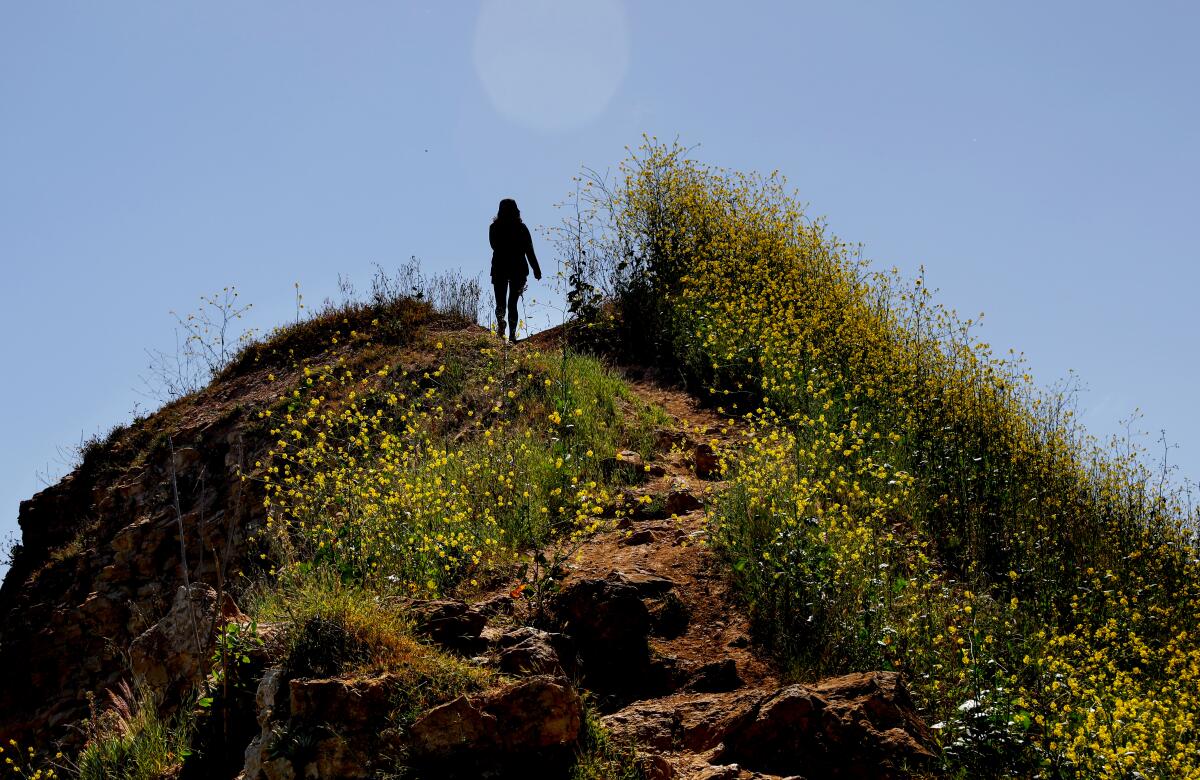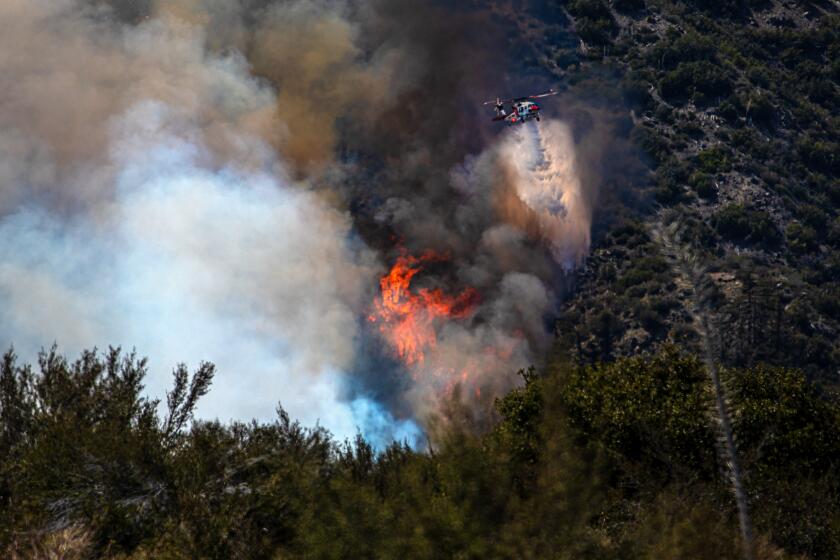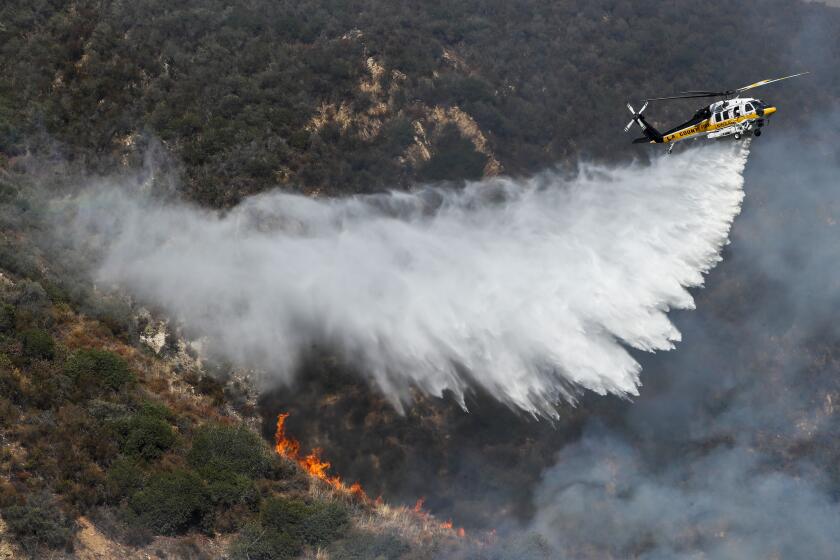Wet winter may delay — but not deter — 2023 fire season; ‘We must not let our guard down’

- Share via
Against a backdrop of rolling green hills at the Prado Helibase in Chino this week, San Bernardino County fire chief Dan Munsey delivered a terse message:
“These hills will turn brown, and they will burn,” he said.
The early outlook for the 2023 fire season arrived as California continues to deal with fallout from this year’s wet winter, including major flooding and record-deep snowpack in the southern Sierra Nevada.
But while the remnants of rain and snow should help keep the state’s vegetation moist longer, there are no guarantees that it will prevent the now-lush landscape from burning, officials said. In fact, it may only serve to delay the start of fire season.
“Don’t let the rain and the snow fool you,” said Joe Tyler, director and fire chief of the California Department of Forestry and Fire Protection. “It will only be a short matter of time before all of those fuels dry out, provide the fuel loading, and potentially have large and damaging wildfires.”
The Nob fire, burning near Lytle Creek in the San Bernardino National Forest, took only a few hours to spread to about 160 acres, according to forest officials.
For evidence, Tyler said, look no further than the Nob fire, which ignited last week in the San Bernardino National Forest and quickly grew beyond 200 acres.
The fire is a “stark reminder that shortly after the snow melts and the rain has gone away, that the fuels are still susceptible to ignitions,” he said. Indeed, the state has already responded to more than 640 wildland fires this year alone, including 135 in the last week.
“As we continue to move forward into the summer — as the grass cures and we begin to see the the brush dry — then we’re going to see a transition into a fire environment that will include that brush,” Tyler said. “Now I would like to arguably say that the timber isn’t going to burn for some time, but we just saw that stark reminder, again, in the Nob fire here last week.”
Still, there are few certainties. After record-breaking, drought-stoked wildfire seasons in 2020 and 2021, last year proved relatively tame, with fewer than 400,000 acres burned across California. In comparison, the state’s worst fire year on record, 2020, saw more than 4 million acres burned.
Tyler and other officials credited the reduction to a number of factors, including more than 109,000 acres of vegetation management work, improved efforts from residents to harden their homes and clear vegetation from properties, and enhanced firefighting capabilities such as aerial attacks at night. Last year, crews logged more than 45 hours of night flights, including over the Fairview fire in Riverside County.
Opponents say there have been considerable environmental changes in the area since the project was first approved 20 years ago.
The state’s $2.7-billion multiyear Wildfire Resilience Program is also “starting to see results” from prescribed burn activities in 42 state parks, about 1,200 fire resilience projects and other similar efforts, said Jessica Morse, deputy secretary for forest and wildland resilience with the California Natural Resources Agency.
But experts said last year’s reduced acreage was also a factor of luck, including some well-time rainstorms that helped quell flames.
Despite being short, last year’s fire season was also deadly and destructive. Flames leveled the town of Lincoln Heights in Siskiyou County, damaged hundreds of structures in Mariposa County and destroyed at least 20 homes in Orange County. Nine people, all civilians, were killed.
For those reasons, officials this week urged residents to remain vigilant.
“Already in 2023, our state has experienced severe flooding and two federally declared disasters. We also know that the rain and snow from these spring storms makes the wildfire risk later in the year even more acute,” said Sherri Sarro, assistant director with the California Governor’s Office of Emergency Services.
She and other officials encouraged Californians to prepare for fires now, including brushing up on evacuation routes, packing go-bags, signing up for county alerts and making plans to protect people and pets.
With the worst of fire season behind us, experts say this year’s reduced fire activity has less to do with strategy and more to do with luck.
The state’s early-season outlook, provided at the start of Wildfire Preparedness Week, mostly squares with that of the National Interagency Fire Center, the Idaho-based command hub for nationwide firefighting response.
That agency’s outlook, also released this week, noted that a “green-up is well underway across much of the West, but fuel moistures are decreasing across the lower elevations of the Southwest and portions of southern California.”
Wet conditions in the region mean the drying of many fine fuels is likely to run at least two to four weeks later than normal in lower elevations, the outlook says. Widespread snow is also likely to lead to a “notably delayed start to fire activity” at higher elevations above 7,000 feet.
But while fire risk is anticipated to be below normal in most of California through June, the risk will elevate to “normal potential” in much of the state by July and August, the outlook says.
Federal officials are also preparing for this year’s fire season, said Jaime Gamboa, director of fire and aviation management with the U.S. Forest Service’s Pacific Southwest Region. About 60% of California’s forests are federally managed.
Gamboa said the agency recently signed a memorandum of understanding with the National Alliance of Forest Owners to “enhance cooperation between work in private forests and public lands during wildfires.” The agreement will increase firefighters’ abilities to conduct initial attacks on blazes in areas adjacent to forest service lands, he said.
Tyler, of Cal Fire, said despite the year’s historic rain and snowfall, “we must not let our guard down.”
“I want to emphasize that wildfire in California will continue, and will remain a part of all of our lives even with this year’s rain,” he said. “It’s not a matter of if, but when, your family will be impacted by wildfire.”








